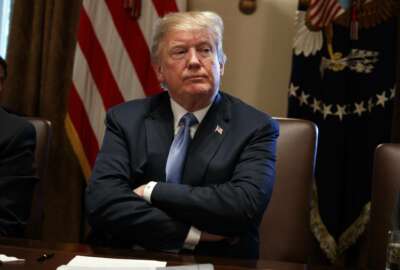
Federal leaders say civil service merit principles are timeless. But is OPM?
The Trump administration's proposal to shift all personnel policy offices currently housed within the Office of Personnel Management to a new entity within the...
The Trump administration’s recent reorganization plan pitches a significant shift of functions within the Office of Personnel Management, but it’s opening up a broader debate about the agency’s role as government’s central personnel office — and what that entity may look like in the future.
Several former OPM leaders and experts agree: the merit principles that ensure federal employees are hired and fired for who they are and what they know — not who they know — are timeless.
But it’s less clear that the agency that’s managed those same merit principles for the past 40 years can also withstand the test of time. And if not OPM, then what?
Several members of the federal community, however, see an inherent problem with the main premise of the administration’s OPM reorganization proposals. Beyond removing OPM’s current security clearance, retirement, health and HR services functions out of the agency, the administration also wants to transfer all personnel policy offices to a new entity within the Executive Office of the President.
They fear that tasking a new office within the White House, a political entity that changes and turns over with every new administration, with creating policy for an political federal workforce contradicts the long-held premise behind the merit system principles that serve as the bedrock for the civil service.
“At best, there’s a perception of political interference in executing merit principle oversight and compliance, if that’s run out of a White House office,” said Linda Springer, a former OPM director during the George W. Bush administration. “At worst, it opens the possibility that that type of political interference could occur. Not only does it eliminate the firewall by having the independent agency to protect the civil service, it also eliminates the firewall that currently protects the White House by not having those things resident in a White House office. It’s very problematic, even if all it is a perception.”
Related Stories
Congress authorized OPM as an independent agency in the Civil Service Reform Act of 1978. The concept of a spoils-merit-based system dates back even further, when Congress created the civil service with the Pendleton Act of 1883.
“It is supposed to be apolitical,” Debra D’Agostino, founding partner and attorney with the Federal Practice Group, said of the federal workforce. “There are rules in place to prevent federal employees from partaking in political activities while at work. Connecting personnel policy to the White House is very different than connecting budget policy, because of the Civil Service Reform Act, because of the Civil Service Commission, because of the entire history of why there’s a civil service.”
But for the Senior Executives Association, the benefits of creating a central HR office within the White House far outweigh these concerns.
OPM has lost focus of its primary mission over the past 40 years, SEA President Bill Valdez said in an interview. Layering on retirement services and security clearance processing, to name a few, inhibited OPM from devoting its undivided attention to its core responsibility: the role of central personnel office, he said.
He compared a potential personnel policy office within the White House to the Office of Management and Budget, which dictates the president’s annual budget and advises government on general acquisition and financial management.
Both the budget and human capital management are core functions of a major corporation’s executive suite, Valdez said.
Details surrounding the administration’s plan to move OPM policy functions to the White House are unclear. According to the administration’s reorganization report, roughly 20 percent of OPM staff work on these policy issues. These career employees have decades of experience crafting policy on performance, hiring and leadership development, and their roles shouldn’t simply disappear, said Dan Blair, a former deputy OPM director during the Bush administration.
“Maybe where it is doesn’t matter, but you need to have that expertise in government,” he said of OPM.
Recent distractions
In addition, multiple cyber breaches in 2015 and a growing backlog of background investigations in recent years have shown OPM isn’t the right entity to serve as the government’s central human resources office, Valdez said. The agency has been distracted by too many responsibilities, and it’s fallen decades behind in properly managing a 21st century workforce.
Former OPM directors agree, the cyber breaches that impacted nearly 22 million federal employees, family members, contractors and others did significantly change the agency, and it hasn’t quite been able to recover since.
“The cyber breach really hurt its reputation,” Blair said. “It hurt its reputation not just in the political class but with rank-and-file feds who felt that their information had not been protected.”
Janice Lachance, who served as OPM director during the Clinton administration, recalled complaints about her agency in the beginning. Vice President Al Gore held town hall meetings at agency headquarters to collect ideas for the administration’s “Reinventing Government” initiative.”
“At every single [meeting], somebody would get up and say to the vice president that the personnel system didn’t work, that OPM wasn’t helpful, that it got in the way and that people couldn’t work done because the HR system was so cumbersome,” Lachance said.
OPM itself went through its own transformation during Lachance’s tenure, when the agency stood up its revolving fund structure and shed more than 1,000 employees.
The White House also gave OPM cabinet-level status during the Clinton administration, a position that other administrations didn’t maintain. Lachance said OPM had a great working relationship with the White House and a “natural tension” OMB.
“OMB has management in its title. HR is a core management function. There’s always a natural tension there between the two organizations, who has the last word, who’s the final sign off on things, ” she said.
“But OPM plays a very significant role,” Lachance added. “It helps if everyone is cooperative and is working together, but at the end of the day, I believe OPM has a very strong and important function that’s embedded in its statutory authority and the merit system, which I think is a cornerstone of our democracy.”
But Springer said the Trump administration’s proposals ignore what OPM has done well over the past 40 years. For her, the agency has continued to administer and manage the Federal Employee Health Benefits Program (FEHBP), particularly well during an often volatile health insurance market.
“This proposal assumes that the prospects for reform are so unlikely in an independent OPM that they’ve decided to move it to GSA,” Springer said. “Ultimately, it will only be successful, regardless of where it is, if it gets the right investment of resources, funding, people, IT to fix and keep those things modernized.”
OPM in recent years consistently hasn’t received the funding and resources it’s asked Congress to provide. The agency has, for example, asked for $32 million to $37 million toward its IT modernization efforts for the last three fiscal years, but Congress has consistently appropriated at lower levels than OPM’s request.
As Congress considers the proposals and acts on some, agencies will look to a central personnel office for guidance on moving employees to new offices, functions or jobs altogether, Springer said. OPM has already been advising agencies as they attempt to reduce the size of their workforces through attrition, but the administration’s reorganization proposals create a bigger role for an entity like OPM.
“A strong OPM right now is more needed than ever to help these other agencies accomplish their reorganization plans,” she said. “Instead, what you’ve done is you’ve sent a signal that you’re going to gut OPM at the very time that you need it to provide human resource guidance on how to carry these things off.”
Can change actually happen?
The administration has said its plans to work with Congress to implement reorganization proposals, but it also plans to use executive and administrative authority to put them into action.
Margaret Weichert, OMB’s deputy director for management, specifically said last week that the administration saw these proposed changes to OPM as ideas that could be implemented today.
D’Agostino said the administration may legally transfer the governmentwide security clearance portfolio from OPM and the National Background Investigations Bureau (NBIB) to the Pentagon.
But the Civil Service Reform Act specifically charges OPM to carry out some of its current functions, including its retirement and health services and policy development, she said. The CSRA created the position of the OPM director and its responsibilities.
“The Civil Service Reform Act lays out the function of OPM,” D’Agostino said. “I don’t see how, unless there’s a new statute, you can change the functions of OPM.”
The statute also dictates the responsibilities of the General Services Administration and the GSA administrator. Changing GSA and its name would also require new statute, D’Agostino said.
Other laws task the OPM director with even more additional functions, ones that are seemingly unrelated to the agency but help other departments implement small pieces of new legislation, Springer said.
“[Reorganizing OPM] will be very hard to do, even if it [was] the right thing to do,” she said.
Copyright © 2025 Federal News Network. All rights reserved. This website is not intended for users located within the European Economic Area.
Nicole Ogrysko is a reporter for Federal News Network focusing on the federal workforce and federal pay and benefits.
Follow @nogryskoWFED





